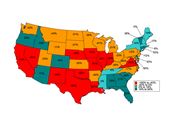|
Hay Stocks And Production
DR. ANDREW P. GRIFFITH
KNOXVILLE, TENN.
Hay stocks across the United States are reported twice per year, once in the May Crop Production report and once in the December Crop Production report. Since the release of the May 1, 2018 report, there have been several articles covering hay stocks, but it is also important to consider hay production for the current growing year. Additionally, hay users and users of the information provided by USDA should remember that the hay market tends to be regional. The bulkiness of hay makes it an expensive product to truck long distances unless the hay is extremely high quality.
Based on the May report, May 1, 2018 all hay stocks (alfalfa and other hay) for the United States totaled 15.669 million tons which is a 35.8 percent (8.719 million tons) decline from one year ago. To put these values in perspective, May 1, 2018 stocks would be equivalent to 31,338,000 bales weighing 1,000 pounds each which would be a reduction of 17,438,000 bales from May 1, 2017. The reduction in May 1 hay stocks is multifaceted. One reason for a year-over-year decline in all hay stocks is a relatively low number of harvested acres. Acreage harvested in 2017 totaled 53.78 million acres which is 5.1 percent fewer acres than the ten year average while yields in 2017 were slightly higher than the ten year average. Fewer acres and a slightly higher hay yield resulted in 2017 production being 2.6 percent lower than the previous year and 3.6 percent lower than the ten year average.
Though the reduction in harvested acres contributed to the decline in hay stocks, Mother Nature may have been the biggest reason for reduced stocks. Texas lost significant hay stocks due to flooding in 2017 while some areas of the country had to resort to feeding hay earlier than normal last fall due to drought conditions. Similarly, some areas experienced harsh winter weather and a terribly late spring which resulted in increased hay disappearance in the early part of 2018.
The attached figure contains year-over-year changes in May 1 hay stocks by state. Looking at the May 1, 2018 hay stock values from a regional standpoint, the only significant increases in hay stocks came in the far Northeast (New York and further north), the deep South (AL, FL, GA, SC,) and a few states in the West (AZ, CO, ID, OR). Alternatively, 25 states had at least a 30 percent reduction in May 1 hay stocks compared to the previous year which includes the largest beef cattle producing states in the country such as Texas (-63 percent), Missouri (-61 percent), and Oklahoma (-52 percent).
When hay stocks are low in May, most in the industry begin looking at the potential to replenish stocks during the next growing season which is in progress. However, the prospects of a strong hay production year seem fleeting. The grass growing year started late in many regions of the country which led to a slow start for cool season grass production. Compounding the situation, spring seemed to last only a few days with extremely hot temperatures setting in which put cool season grasses in the reproductive stage very quickly following spring growth. Not to be outdone, drought conditions have been present in much of the Southern Plains and Southwest United States through the first half of the year which has negatively impacted forage production. Though drought conditions have been present for most of the year, the total area impacted has shrunk since February.
Looking forward, there is still time to replenish hay stocks for the 2018-2019 winter feeding season if favorable conditions occur. Alternatively, any type of drought situation could easily burn the candle from both ends by reducing hay production in 2018 as well as increase summer disappearance as cattle producers could be forced to feed hay. ∆

Figure 1. Percent change in May 1 Hay Stocks (2017-2018)
Source: Livestock Marketing Information Center
|
|